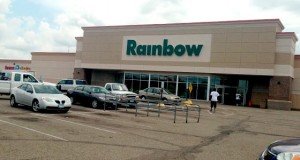By JANE MCCLURE
 For the last few months, the fate of Rainbow Foods in the Midway Center was questionable. But, after a sale, and short closure, Rainbow remains open under its new owner SuperValu. (Photo by Tim Nelson)[/caption]
For the last few months, the fate of Rainbow Foods in the Midway Center was questionable. But, after a sale, and short closure, Rainbow remains open under its new owner SuperValu. (Photo by Tim Nelson)[/caption] Development of a Major League Soccer stadium on Midway Center and former Metro Transit Snelling bus garage properties is expected to kick off in mid-May with initial site work. Representatives of more than a dozen city departments and regional agencies spent part of Valentine’s Day reviewing detailed construction drawings for the stadium and part of the superblock bounded by St. Anthony, Snelling and University avenues, and Pascal St.
Site work will be done in tandem with the demolition of the western part of Midway Center, said Greg Huber of Mortenson Construction, lead contractor on the $150 million stadium project. That will include Rainbow Foods and some stores to the east.
It’s not clear how many shopping center businesses will be forced to relocate or close. Plans show Big Top Liquors, which is in a separate building along Snelling, and businesses in buildings along University Ave., including McDonald’s and Perkins restaurants, remaining open as the stadium is built.
Once demolition and site work are done, initial foundation and structural work on the stadium itself gets underway. Mortenson hopes to have those construction plans submitted to city officials by mid-March. Permits for that work need to be in place by the end of June, said Huber.
Final permits and plans for the rest of the 20,000-seat stadium should be ready this fall. The team hopes to play in the stadium in 2018, but 2019 may be more likely.
Work on the stadium and other parts of the site, including access points, public plazas and the “great lawn” north of the stadium will be done concurrently, Huber said. “Some things will have to wait because there is a building in the way.”
What’s still not clear is how the Midway Center site beyond the stadium itself will ultimately be redeveloped. Jeff Shopek of the engineering firm Loucks explained that plans are changing to reflect current ideas, rather than an ambitious Midway Center redevelopment plan unveiled last year during the master plan process. That plan showed high-rise buildings, dense retail and hospitality uses, apartments, and two hotels.
Shopek said that plan and a related Alternative Urban Areawide Review or AUAR reflected maximum redevelopment potential. “Now we’re getting down to reality,” he said.
In January the St. Paul Port Authority entered into a master lease for the Midway Center, to help spur along site redevelopment. The Port hopes to announce major tenants soon.
Monte Hilleman of the Port Authority said plans call for the site to be redeveloped, west to east, with the initial redevelopment along Snelling. He said the initial development will take a few years to roll out, with total site development taking a decade or more. Some of the sequencing has to do with when leases in Midway Center expire.
“The area along Snelling is more attractive to developers and will be transformed over the near term,” Hilleman said.
The site plan review for the MLS stadium began in spring 2016. The St. Paul City Council approved the project site plan and superblock master plan last year, with the understanding that a myriad of project details would follow.
Many detailed construction drawings have been submitted to the city and are under review. The plans include documents for site grading, environmental cleanup, disability access, bus staging, demolition of buildings, installation of utilities and construction of the stadium and its public spaces.
Larry Zhang, who oversees site plan review for the city, said the stadium plans are complex and involve a number of city, county, regional and state agencies. One issue being discussed is who is responsible for the various maintenance needs. The street and transit discussions alone involve four agencies—Metro Transit, Minnesota Department of Transportation (MnDOT) and St. Paul and Ramsey County Departments of Public Works.
“We’re going to have many items going forward at the same time, but at some point, they have to connect as part of the development,” said Zhang. He emphasized that the developers need to work closely with the city. “I’ve seen smaller projects than this go south because things don’t get caught in the planning stage.”
Huber said the developers need to meet with neighbors soon and to work with the city and MnDOT on issues centered on Snelling Ave. traffic. One issue is the routes to transport excavated soil out of the site.
One sticking point may be street access along Snelling. Shields Ave. currently ends at Snelling, but would extend east to Pascal to serve the stadium. It would be just north of the stadium itself. One idea floated is to have a traffic signal at Shields and remove the signal currently at Spruce Tree Dr. But Metro Transit has objected to the loss of that signal because the Spruce Tree signal is key to allowing pedestrians to cross for Green Line, A Line, and other bus route connections. The signal placement issue has to be looked at, according to city staff.
Comments
No comments on this item Please log in to comment by clicking here